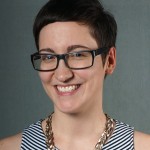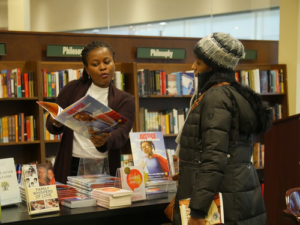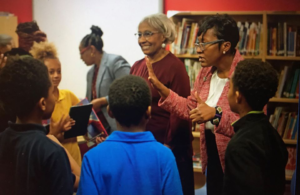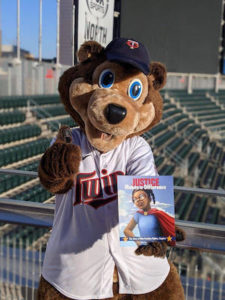PUBLISHED JULY/AUGUST 2021
interview by
Alexa Schlosser, Managing Editor,
IBPA Independent magazine --

Alexa Schlosser
Dr. Artika R. Tyner, founder of Planting People Growing Justice Press and Bookstore, speaks on organic partnerships, what it means to be community focused, and the importance of having a vision and goals.
How did Planting People Growing Justice Press and Bookstore start, and what is your mission?
We were founded with the goal of ensuring that representation was a part of our mission, to make sure that we were representing local authors and authors from diverse backgrounds, and, more importantly, making sure that we were promoting literacy and education and a love of reading for the entire family. For us, it was an opportunity to bring our local community together, and then, over time, bringing the national community together around critical topics. For instance, we’re now organizing a program around criminal justice and the correlation between illiteracy and future incarceration. So, we also use the platform of our bookstore and our publishing company to build awareness and mobilize people around key issues from civic engagement to public health.

Dr. Artika R. Tyner
Your book Justice Makes a Difference: The Story of Miss Freedom Fighter, Esquire, won an award for “community-created writing.” Can you define that for me?
I think it’s key to be connected to the community and develop content, share information, and knowledge. As it relates to
Justice Makes a Difference, even the characters in the book exemplify a piece of community: a grandmother is teaching her granddaughter about the heroes and she-roes that made a difference in civil rights and human rights. Community creation is about creating the type of content that would inspire those ordinary people to have extraordinary impact in their community. Our books focus on leadership development through an intergenerational approach—either the books that we publish or our curated book lists. How do we inspire everyday people with the tools and information that they need to make a difference in the world?
What is the key to collaboration between libraries and local authors?

To be honest, that’s a work in progress. I would love to see more. When you look at local libraries, they tend to focus on
The New York Times bestsellers. It’s wonderful to promote those books—they’re great—but at the same time, wouldn’t it make a greater impact if you’re promoting a book of a local author or someone that people could know, could connect with, could build a relationship with, could support their grassroots efforts?
The community-created award opened my eyes to the dire need for libraries to have a clear actionable plan around equity—an equity statement, intentionality, strategic action around how they hope to promote it at a local level and how they will engage with local authors. Winning the award has been very eye-opening because a part of it was to build more connections with local libraries. In Minnesota, there are over 100 libraries. So far, our award has only connected us with two libraries, and that’s with the award.
What would you say is the roadblock there?
I think there are multiple. One is the libraries’ own lack of diversity. A library and their staffing and administration should reflect the world we live in. If you’re not representative in your own staffing, how will you reach and connect with a community? And let’s just take it a step further. As a civil rights attorney, I would be remiss not to bring in another dimension of this. We know that libraries as public spaces used to be segregated. So, you still have to grapple with the library having a complicated history. Until you grapple with that and ensure that it’s truly a welcoming and inclusive place, you can’t even get to the book selection; you first have to get to the place in the facility.
With Aya’s Place, you partnered with LiLu Interiors to create a space for people to connect with their inner artist. Why was this important to you, and how did you get connected with LiLu?
It’s critically important to have places where writers and artists can come together, reimagine, and create the world that we want to live in. Artists reflect the reality of what they see, but they’re simultaneously creating new realities. As I thought about the murder of George Floyd, and seeing everything unfold out of my own front window, I thought, “What can I do to create those spaces around racial justice, around healing, around reconciliation? What would it look like?” And the first thing that came to me, as I was watching everything, was to think about how to unleash the artists, to bring the artists into this conversation—whether it’s a literary artist, a photographer, a sculptor, a playwright. How do we bring them into this conversation on where we need to go and how we get there?

I believe in natural connections. Most things with me start with a conversation. I thought to myself, “Who could help design it if I found a space?” Immediately I thought about my friend and colleague, Lisa Peck, the principal and founder of
LiLu Interiors. We’d worked together through Girl Scouts—I’m an alumna. This is what I mean about connections matter. I thought to myself, “I’m not a designer. I have no idea where to even begin. I just have a chair and a sofa in here.” I wanted to create the type of welcoming space that would cultivate the type of innovation that we need. Lisa Peck and her team answered the call. I told them the most important piece for me is for it to look like back home in Ghana. We brought together the art, the handdyed cloth, the decorations. It became more than just another experience; it became a remarkable opportunity to create the type of space that we need, not just in Minnesota, but across the nation.
We were able to do create a warm, welcoming space that’s community centric and culturally specific, so if you want to create and you need a space to create, you can. This was especially important in the midst of COVID-19. I’m a writer; I’m used to going to writer’s retreat centers for a month or for a few days. Here I am in the midst of COVID-19, sitting in the same chair for 17 months. I could feel it personally that my creativity was a fleeting experience. There’s only so much you can do at home. So, we also needed a space in the midst of COVID-19 where people could come and not have to worry about the idea of being in the chaos of your day-to-day life.
Do you have any advice for others searching for unique partnerships, whether the goal is to enrich the bottom line or to enrich the soul?

I don’t look for partnerships; partnerships find me. Part of it is your relationships. When I go through my phone, or when I look through my email list, I have a relationship with everyone there. You can easily take inventory of—if you have an idea, or someone even calls you with an idea—what resources are available to you.
Aya’s Place, if it were not for LiLu and the resources of people volunteering, coming to paint the space, and getting involved, we never would have accomplished it in such a short period of time, if at all. Oftentimes, we wait to build partnerships when we need something, or when we’re trying to accomplish something; but for me, it’s a way of life, and it’s a business practice. Being a small, grassroots press and bookstore, most of the work we’ve done, and most of the things we’ve achieved, have all been in-kind donations or by supporting each other with a little bartering—whatever it takes to get our small businesses off the ground. I’ll give you a perfect example of this. I recently joined a small business network. I asked the question: We have the bookstore; we have the online store, which has been integral to our success during COVID-19; but what about the other ways to expand our audience and get our books in the hands of others? I got on that business call, and I said I would love to make sure by the end of the year, we have 20 community retail partners—to sell the books at the carwash, to sell books at the local grocery store, the bowling alley—let’s get books in front of people. So, tell me, I said, who are the retail partners that are open to selling products? One right away was a local grocery store, deli, and restaurant called Minny Row Market. I reached out to Minny Row, to the married couple and owners (Dana and Peter Smith), and I said, “Tell me more about what you’re trying to do so I can help support and promote your work. And then let’s see if you can also support and sell our books.” And they said OK. I just went there last week with one of our staff members. We went, and we didn’t just go to their store to support, we went down that whole block. And then we went down to the next block. We went probably a mile down Main Street and Hopkins. What did we do? We built relationships and went in each business, found out what people needed, and how we could support.
Tell me about the grant you received from the Metropolitan Regional Arts Council through the Minnesota Disaster Recovery Fund.

We have a foundation, the
Planting People Growing Justice Leadership Institute, and its purpose is to get books in the hands of children and offer the programming and help to enhance literary arts and engagement around social justice topics. That’s why we were interested in grants and exploring them. We wanted to donate 1,000 copies of the
Justice book. We basically built the bookstore as a social enterprise around the
Justice book to ensure that we were able to donate books, do programming, and engage with the community. So, our model is different. I’m assuming most bookstores are just a bookstore-for-profit corporation. We are a social enterprise. We are a for-profit bookstore and publishing house that has a philanthropic mission, as well. Therefore, for instance, when you buy a book, a percentage of the proceeds from all book sales go back to the nonprofit so we can continue the work. It eventually became more than donating 1,000 books. Five years later, we have donated 7,000 books, and our numbers continue to grow.
But for that particular grant, I was in the community, and I started asking folks how do we build more momentum and start getting young people and community members to write their own stories? Some folks said, “Well, you can create the opportunities.” I’m like, OK, but we need to finance them; what does it look like? And then someone said, “Why don’t you try some grant opportunities and get some additional support?” That particular grant was also helping to build the capacity of a nonprofit. One of the things that we wanted to expand into is youth writing competitions, and just overall writing competitions, to help diversify the publishing industry and for cultural preservation, to tell our stories accurately.
Do you have any advice for how other publishers might tap into their own community and start building those connections that lead to bigger projects?
I think we need to reimagine what it looks like to have community connections. A book is a catalyst for bringing forth nonviolent resistance. A book is a catalyst for training the next youth Poet Laureate like Amanda Gorman, or the next advocate, like Stacey Abrams. A book can open up minds and hearts and bring people together in ways that we can’t imagine. So, how do we put that public good with the business interest? Behind me, there’s a plush doll. [It came] from a business partner. I was just casually talking about the importance of black dolls with someone, and I went back to our P.O. Box and someone wrote a check to cover the full production for that doll. They said, “I want you to get that in the hands of children and inspire, in particular, children of color to love who they are.” For me, this all ties together—education, awareness, community building, and social impact—it all ties back to the mission.
Some people might read this article and go, “Oh my goodness, we have to become a social enterprise.” That’s not what I’m saying. What I’m really encouraging everyone to do is go back and look at your mission and vision statements. What’s your goal? What do you seek to impact? What does success look like? And yes, it’s in monetary terms. We have to pay our lease, we have to buy inventory, and we pay our authors. But, in addition to that, what else can we do to help radically transform our communities? I think each of us can have a sense of agency, and through the power of partnerships, we have limitless potential. There’s something in human nature that makes people want to be involved and want to give back in meaningful ways. Sometimes we forget it, but we are stronger together than we are apart.
Alexa Schlosser is Managing Editor of IBPA Independent
magazine.